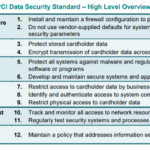In this incisive exploration titled “Understanding the Latest Changes to PCI-DSS and Their Implications”, we decode the recent alterations to the Payment Card Industry Data Security Standard (PCI-DSS) and examine the consequential effects they could have on your business. As you navigate the intricate terrain of digital transactions and data security in your operations, being aware of these modifications and comprehending their potential outcomes can be crucial for maintaining compliance and ensuring the secure handling of sensitive cardholder information.
Understanding PCI-DSS
The Payment Card Industry Data Security Standard (PCI-DSS) is an established set of requirements designed to guarantee that all organizations processing, storing or transmitting credit card information maintain a secure environment. The primary objective of the PCI-DSS is to protect cardholder data. This standard has crowned itself as a major component of the data security landscape, and understanding it is vital for any business handling cardholder information.
Basics of PCI-DSS
The basics of PCI-DSS revolve around the security of cardholder data. The PCI-DSS is managed by the PCI Security Standards Council, which was created by major card brands including Visa, MasterCard, and American Express. The standard incorporates twelve requirements for building and maintaining a secure network, protecting cardholder data, managing vulnerability, implementing strong access control measures, regularly monitoring and testing networks, and maintaining an information security policy.
Importance of PCI-DSS
PCI-DSS has significant importance in today’s digital age where credit and debit card transactions are increasingly common. The standard helps businesses refrain from card data theft and decrease the likelihood of cardholder data breaches. Besides protecting consumer data, it also helps businesses protect their reputation and prevent damaging financial consequences that often accompany data breaches.
Who is affected by PCI-DSS
Every entity that stores, processes, or transmits cardholder data is required to comply with PCI-DSS. It influences a wide range of players in the payment industry, including merchants, processors, acquirers, issuers, and service providers. Even if you are a small business that accepts credit card payments, you must comply with PCI-DSS to ensure the security of that information.
Historical Changes in PCI-DSS
PCI-DSS is not a stagnant standard. It has evolved over time to cater to emerging security threats and technological advancements.
Evolution of PCI-DSS standards
Since its inception, the PCI-DSS standard has undergone multiple updates to improve security measures in response to the changing threat landscape. Over the years, PCI-DSS has improved its security requirements and has expanded its scope to include areas like network segmentation, encryption, and multifactor authentication.
Reason for changes in PCI-DSS
The primary reason for changes in PCI-DSS is the continuously evolving cyber threat landscape. Cybercriminals are always finding new ways to exploit vulnerabilities and breach security measures, making it critical for standards like PCI-DSS to keep pace and offer protection against emerging threats.
Impact of past PCI-DSS changes
Changes to PCI-DSS have continually had a major impact on organizations that process cardholder data. With each evolution, businesses have been required to adapt their security practices to ensure compliance and protect cardholder information effectively. Non-compliant entities face potential financial penalties and reputational damage.
Overview of Latest Changes to PCI-DSS
As part of its commitment to keeping up-to-date, the PCI-DSS standard has recently introduced significant changes.
Details of the updated PCI-DSS standards
The updated PCI-DSS standard continues to refine and expand the security requirements to appropriately handle emerging threats. Key changes include enhanced encryption requirements, a shift to multi-factor authentication, and new requirements for service providers.
Official announcement of changes
The PCI Security Standards Council officially announced the changes to the PCI-DSS standard. The amendment was released as part of a broader effort to improve credit and debit card security in response to increasing rates of data breaches and fraud in the digital payment ecosystem.
Effective dates for new PCI-DSS standards
The official announcement came with effective dates for the updated standards. Post announcement, the companies were given an adjustment period to align their security measures with the new requirements.
Specifics of the New PCI-DSS Standards
The latest changes to the PCI-DSS standard involve several key components of the payment processing ecosystem.
Updates on encryption requirements
To counter increasingly sophisticated threats, the updated PCI-DSS standard includes enhanced encryption requirements. These are designed to protect cardholder data and secure transactions from end-to-end.
Changes in two-factor authentication
Another significant change is the transition to multi-factor authentication. Multi-factor authentication reduces the risk of unauthorized access by requiring multiple forms of verification prior to granting access.
Adjustments on service provider requirements
One of the most comprehensive changes is in the service provider requirements. Service providers are now required to maintain additional controls and conduct more frequent reviews and assessments of these controls.
New requirements for virtual payment processes
The updated PCI-DSS standard includes new requirements for secure virtual payment processes, following the advent and rapid adoption of online transactions.
Motivations Behind the Latest PCI-DSS Changes
Multiple motivations prompted the latest changes to the PCI-DSS standard.
Reaction to emerging dangers in digital payment
A major motivation for the updates is the emergence of significant threats in the digital payment landscape. With new threats evolving, stronger and more detailed security measures are needed.
Desire for increased consumer protection
A guiding motive behind the updates is the desire to provide greater consumer protection. The rising incidence of cardholder data breaches has threatened consumer trust in digital transactions, making it a top priority for the PCI Security Standards Council to implement more robust data protection measures.
Move to promote consistency in payment security
Consistency in payment security across different platforms and entities is another key motivation. The changes aim to ensure that all organizations handling cardholder data meet the same rigorous standards, regardless of their size or volume of transactions.
Benefits of the Latest PCI-DSS Changes
The new PCI-DSS standards bring several benefits.
Improved consumer data protection
Arguably the most significant benefit of these changes is noted in the improved protection of consumer data, allowing a much safer environment for cardholder data during transactions.
Enhanced trust and confidence in digital payments
With the new standards, customers can feel more secure performing digital transactions, thus cultivating increased trust and confidence in these transactions.
Demand increase for compliance expertise
The complexity of the new standards has prompted a rise in demand for compliance expertise, creating new opportunities for professionals in this field.
Challenges with the Implementation of New PCI-DSS Standards
Despite the clear benefits, implementing the new PCI-DSS standards is not without challenges.
Increasing complexity of compliance
One major challenge comes with the increasing complexity of compliance. Businesses often need to adjust significantly to meet new requirements, and this may necessitate training, new technology, or reconfigured processes.
Cost implications
The cost of compliance is another significant hurdle. Implementing new security measures and adapting to updated standards often comes with its own costs, which can strain the resources of some businesses.
Technical challenges
Overcoming technical challenges, such as upgrading systems or implementing new security practices, can also be a significant hurdle for many businesses.
Tips for Adapting to the New PCI-DSS Standards
Successfully adapting to the new PCI-DSS standards can be less challenging with the right strategy.
Formulating an effective implementation strategy
An effective implementation strategy is a key to navigating the changes successfully. Create a detailed plan that includes modifications in technology, staff training and changing business processes.
Necessary technology upgrades
Turn the challenge of implementing new standards into a chance for an overall security upgrade. Adopt the latest technologies and security practices to not only meet compliance standards but also bolster your organization’s overall security posture.
Staff training on new standards
Ensuring that all staff members are fully aware of and understand the new standards is crucial. Educate your team about the changes, why they matter, and how to apply them.
Finding the right compliance partner
The right compliance partner can guide you through the changes and ease your path to compliance, simplifying the process and potentially saving you time and resources.
Implications of Non-compliance with the PCI-DSS standards
Non-compliance with the PCI-DSS standards can lead to a multitude of repercussions.
Reputation damage
Non-compliance can significantly harm an organization’s reputation. Customers losing trust in an organization’s ability to safeguard their data may ultimately choose to take their business elsewhere.
Financial penalties
In cases of non-compliance, financial penalties can also ensue. These are levied by the card brands themselves and can range from hefty fines to increased transaction costs.
Legal issues
Depending on the severity of the breach, non-compliant entities may also face legal consequences, including lawsuits from consumers, card brands, or other affected parties.
Future of PCI-DSS
The future of PCI-DSS will depend in large part on how payment technologies, user behavior, and the threat landscape evolve.
Prospective shifts in global payment culture
As digital payments continue to evolve at a fast pace, PCI-DSS will need to adapt in order to keep up. New payment methods, new platforms, and new security threats will require further updates and refinements to these security standards.
Payment innovations and the implication for PCI-DSS
Payment innovation is an essential factor in the future of PCI-DSS. The rising use of blockchain technology, biometrics, quantum computing, and other advancements will likely influence changes in PCI-DSS to maintain robust security measures.
Anticipated future updates in PCI-DSS
As technology and threats evolve, updates and amendments to PCI-DSS will be inevitable. Entities can expect the standard to continue its trend of protecting against emerging threats and aligning with new payment technologies, just as it has done in the past.
In conclusion, understanding PCI-DSS standards, particularly the latest changes, is critical for businesses that deal with cardholder data. By staying compliant, businesses can ensure they protect their customers’ data, retain their trust, and avoid penalties. It’s crucial to anticipate future changes and be prepared to adapt, ensuring your business remains compliant and secure in an ever-changing digital landscape.










